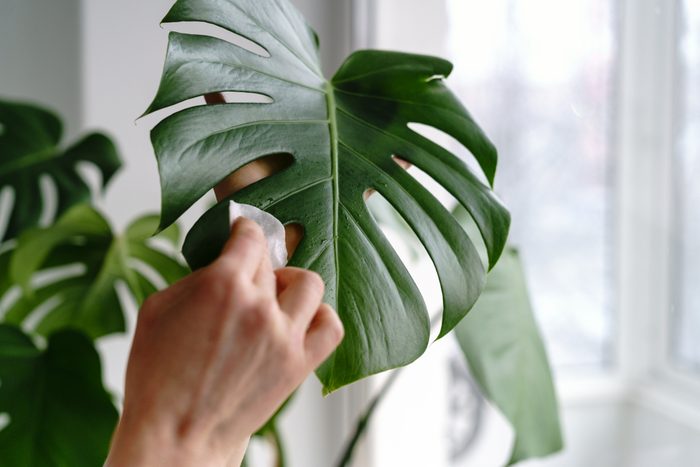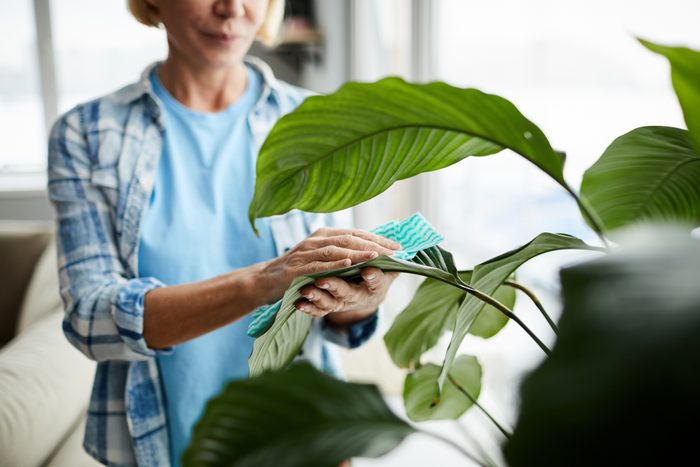You know you have to water houseplants, but did you know you should also dust them? Dusting houseplants is easy and vital for healthy, happy plants.
You Should Dust Your Houseplants— Here’s Why

Dusting Lets in the Light
Plants make their own food through photosynthesis, harnessing light — sunlight or artificial — to change carbon dioxide and water into glucose and oxygen. Plants keep the glucose for food and release oxygen into the air— that’s why they’re so good for the environment. Steinkopf says dust prevents light from reaching the leaves of a plant, reducing its ability to photosynthesize.

Dusting Reduces Allergens
Dust doesn’t just affect a plant’s health, but a person’s, too. Dusty plants, like a dusty coffee table or window sill, contribute to poor indoor air quality. They can be particularly problematic for people with allergies.
Dust mites live in and feed on dust in your home, and they’re a major trigger for asthma. Yet the American Lung Association says that not many people are dusting these days. Buck the trend and do your health a favor: Dust your plants!

Dusting Makes Plants Look Better
Why do we have houseplants? They’re beneficial, certainly. And studies show plants can reduce stress, increase workplace productivity and offer comfort in hospitals and mental health facilities.
Often, though, we just like the way they spruce up the place. Cheery, vibrant plants make your home a home. Don’t underestimate the importance of aesthetics with plants and dust.
According to Steinkopf, “[There’s] nothing worse than a dust-covered, sad plant.”

Dust Every Time
Steinkopf recommends dusting your houseplants every time you water. If you can’t do it every time, dust at least once a month. Make it part of your routine so you don’t forget. “Keeping your plants clean is important,” Steinkopf says.

Use a Paintbrush
Fuzzy-leaved plants like African violets need a delicate dusting tool that won’t harm their soft leaves. Steinkopf says a soft baby hairbrush or paintbrush works well for these fuzzy flowering plants. That layer of fluff protects the plant from pests and temperature fluctuations, so use a light touch.
This method also works great for getting in between cacti spines.

Wear Soft Cotton Gloves
To dust larger plants like monstera, anthuriums or philodendrons, Steinkopf suggests putting on soft cotton gloves. Hold the leaves between your hands and carefully wipe them clean while supporting them from underneath. This gentle technique takes care of the dust and keeps the leaves from breaking off.
Machine-washable microfiber dusting gloves are safe for plants and last for thousands of uses.

Give Them a Shower
Dusting every leaf in your home could take a while. For your more portable plants, place them in the sink or bathtub and rinse them with water to remove dust and dirt in one fell swoop. It works great and saves time. “A good shower is perfect for any plant,” Steinkopf says.
Allow the plant to dry out of direct sunlight. If water pools in the center of the plant, blot it with a tissue or paper towel. Leaving standing water in the plant could cause it to rot.

Wash Your Tools
Whatever tools you use to water and dust your plants, it’s important to wash them frequently. Besides dust mites, plants could harbor pests like aphids, fungus gnats, scale and others. The last thing you want to do while cleaning your indoor plants is transfer bugs between them.
Rinse your gloves periodically as you’re cleaning, and throw them in the washing machine when done. For paintbrushes or other tools, warm soapy water should do the trick.





















